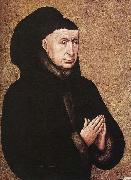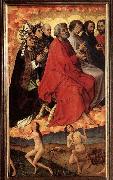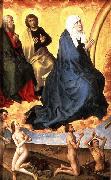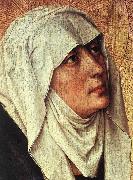
|
Artists
Index
|
||
|
WEYDEN, Rogier van der
|
||
|
The Last Judgment Polyptych new21/WEYDEN, Rogier van der-497572.jpg ID de tableau:: 63887 |
1446-52 Oil on wood Mus?e de l'H?tel Dieu, Beaune The detail shows Chancellor Nicolas Rolin, founder of the H?tel-Dieu in Beaune from one of the outer panels of the Last Judgment Polyptych. The donor of the Hospices de Beaune must have been an extremely powerful and wealthy man to finance such an undertaking. Nicolas Rolin spent nearly sixty of his eighty-one years in the service of the Dukes of Burgundy. For twenty years he was their legal advisor; he spent the remaining years as chancellor. A chancellor in the Middle Ages was a "superminister" combining the functions of Minister of Finance, Home and Foreign Affairs and others. It is not surprising that a capable and intelligent man holding so much power and with more than half a century in the favour of one master, should amass considerable wealth. And that master was no ordinary man. Philippe-le-Bon (Philip the Good), Duc de Bourgogne, Grand Duc d'Occident, could say without exaggeration that "I could be king if I so wished". He was a vassal of the King of France, but infinitely richer and more powerful than the unfortunate Charles VII. Through a series of judicious marriages and annexation of lands after victories, the Dukes of Burgundy, from the days of Jean-Sans-Peur (Fearless John), built up vast spheres of influence, a patchwork of regions and races extending around the Kingdom of France in a crescent from just north of Lyons to just south of Amiens and from there to northern modern Holland. Philippe-le-Bon entrusted the management of this vast domain to Nicolas Rolin. Certain chroniclers contend that his management was not entirely disinterested and that the magnificence of the Hospices directly reflects the degree of his remorse for his actions. Nevertheless, it has been recorded that, assailed by criticism and reproaches and accused of misappropriation of funds, Nicolas Rolin, in order to silence envious tongues, appeared before Philippe-le-Bon dressed in the humble robes of a lawyer with a list in his hand and offered to return all the gifts which the Duke had showered upon him. The Duke refused this offer and was pleased that there was still room on this list for further gifts! There was nothing to indicate that the Rolins, a modest family from Autun, were destined for such greatness. Nicolas needed unrelenting determination and persistence to successfully ascend the social ladder. As Councillor to Jean-Sans-Peur and, after 1422, Chancellor to Phillipe-le-Bon, Nicolas Rolin showed himself to be not only an able administrator but also a canny politician who succeeded in extricating the Duchy of Burgundy from an alliance with the English which became onerous after the glorious progression of Joan of Arc and the change in fortune of Charles VII. He was also one of the authors of the Treaty of Arras, the instrument which reconciled France and Burgundy and ended the Hundred Years' War. Nicolas Rolin's pride and authoritarian nature are clearly reflected in the first words of the charter creating the Hospices, "I wish and hereby order... I wish and hereby devise that... ". In 1443, desirous of helping Beaune, the city of his mother's birth, recover from the devastation of the Hundred Years' War, Nicolas Rolin decided to build a hospital, "ignoring all worldly concerns and in the interests of my salvation ". After the main outlines of his project were established, Rolin, enamoured of the richness of Flemish architecture, imported an artist - thought to have been Jean Wiscrere - from the "flat country" to construct the Hospices in the image of the H?pital Saint-Jacques in Valenciennes. The Chancellor had initially calculated that the work begun in 1443 would take five years. In fact, the building was not dedicated until December 31, 1451. Nicolas and his wife, Guigone de Salins, welcomed six nuns from Flanders the next day and the first patient was admitted several hours later. The last patient left the Hospices in 1971, 520 years later.Artist:WEYDEN, Rogier van der Title: The Last Judgment Polyptych (detail) Painted in 1401-1450 , Flemish - - painting : religious | |
| |
|
|
|
|
||
|
The Last Judgment new21/WEYDEN, Rogier van der-467925.jpg ID de tableau:: 63888 |
1446-52 Oil on wood Mus?e de l'H?tel Dieu, Beaune At the far left-hand side of the polyptych, paradise is represented as a gothic porch ablaze with light, the door that leads to the divine dwelling place. On the other side, hell is strangely lacking in devils. Instead, it is merely represented by a pile of dark rocks spewing flames and volcanic vapours.Artist:WEYDEN, Rogier van der Title: The Last Judgment (detail) Painted in 1401-1450 , Flemish - - painting : religious | |
| |
|
|
|
|
||
|
The Last Judgment new21/WEYDEN, Rogier van der-776882.jpg ID de tableau:: 63889 |
1446-52 Oil on wood Mus?e de l'H?tel Dieu, Beaune Above is a cloud of gold, on which are seated the apostles, judges in the celestial tribunal, as well as a pope, a bishop, a king, a monk and three women. Below them is the earth, from which the resurrected souls emerge, to go either to damnation or to eternal bliss.Artist:WEYDEN, Rogier van der Title: The Last Judgment (detail) Painted in 1401-1450 , Flemish - - painting : religious | |
| |
|
|
|
|
||
|
The Last Judgment new21/WEYDEN, Rogier van der-938987.jpg ID de tableau:: 63890 |
1446-52 Oil on wood Mus?e de l'H?tel Dieu, Beaune The central panel is dominated by the son of God, seated on a semi-circular rainbow, with the Virgin Mary at one end of the arc and St John the Baptist at the other.Artist:WEYDEN, Rogier van der Title: The Last Judgment (detail) Painted in 1401-1450 , Flemish - - painting : religious | |
| |
|
|
|
|
||
|
The Last Judgment new21/WEYDEN, Rogier van der-269429.jpg ID de tableau:: 63891 |
1446-52 Oil on wood Mus?e de l'H?tel Dieu, Beaune The detail shows the head of Mary.Artist:WEYDEN, Rogier van der Title: The Last Judgment (detail) Painted in 1401-1450 , Flemish - - painting : religious | |
| |
|
|
|
|
||
| Artiste prochain | ||
|
Also Buy::. For Following Paintings / Artists / Products, Please Use Our Search Online: |










